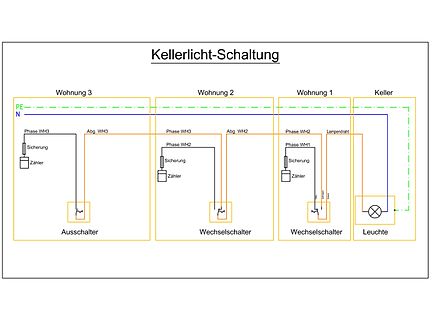House switching
The house circuit (also HS circuit , Swabian home circuit , Schwaben circuit or basement light circuit ) is a special form of a two-way circuit , which should ensure in the 1950s to the 1980s, that the cost of electricity off of an electric lighting of the basement of an apartment building, which has been forgotten by the person who has forgotten to turn it off.
The electrical circuit and the function
House switching is based on the use of switches which, from a technical point of view, are approximately the same as those of commercially available two-way switches . Only the increased dielectric strength for use up to 380 V differed from the changeover switches at that time, which were previously only approved for use at 220 V.
An (any) outer conductor is routed through any number of changeover switches, as shown in the adjacent circuit diagram, until the circuit to the consumer , the lamp in the basement of an apartment building, is closed and the basement light is lit.
Basically, the idea of this circuit, which was primarily used in the Baden-Württemberg area from the 1950s to 1970s , was that the living party who switched on the cellar light should also bear the costs incurred, as the electricity required for this was via the respective electricity meter of the relevant residential party. The electricity consumption is paid for by the resident who left their cellar light switch on.
A practical peculiarity was the fact that the living party who was closest to the cellar light and who, through their own fault, left the cellar light switched on, always had to bear the full electricity costs. With the other, downstream house parties, there was the possibility that another house party closer to the cellar light also forgot to switch off the cellar light - in this case this party took over the electricity costs.
In principle, with this connection, whoever pays for the electricity
- has switched on the cellar light at its own switch and
- In the electrical series connection, the changeover switch is closest to the cellar light.
hazards
Using the house circuit also created dangers. Since there are several circuits that lead to the cellar light, the absence of voltage is not guaranteed by just disconnecting one circuit from the living room by removing or switching off a fuse. The incandescent lamp in the basement light could be supplied by different living parties depending on the switch position, depending on which living party had just switched on their basement switch.
Today's approval
Since April 1988, house switching is no longer intended for new installations in accordance with DIN-VDE 0100-550. As for all existing electrical installations, a kind of "inventory protection" applies (more precisely: no retrofitting obligation), which, however, expires as soon as the existing electrical installation is changed, expanded or newly installed.
Individual evidence
- ↑ House switching. In: effipump.de. Retrieved November 12, 2015 .
- ↑ ▷ Inventory protection for older systems. In: elektrofachkraft.de. Retrieved November 12, 2015 .
Web links
- The "old" basement light switch : HS switch at effipump.de
